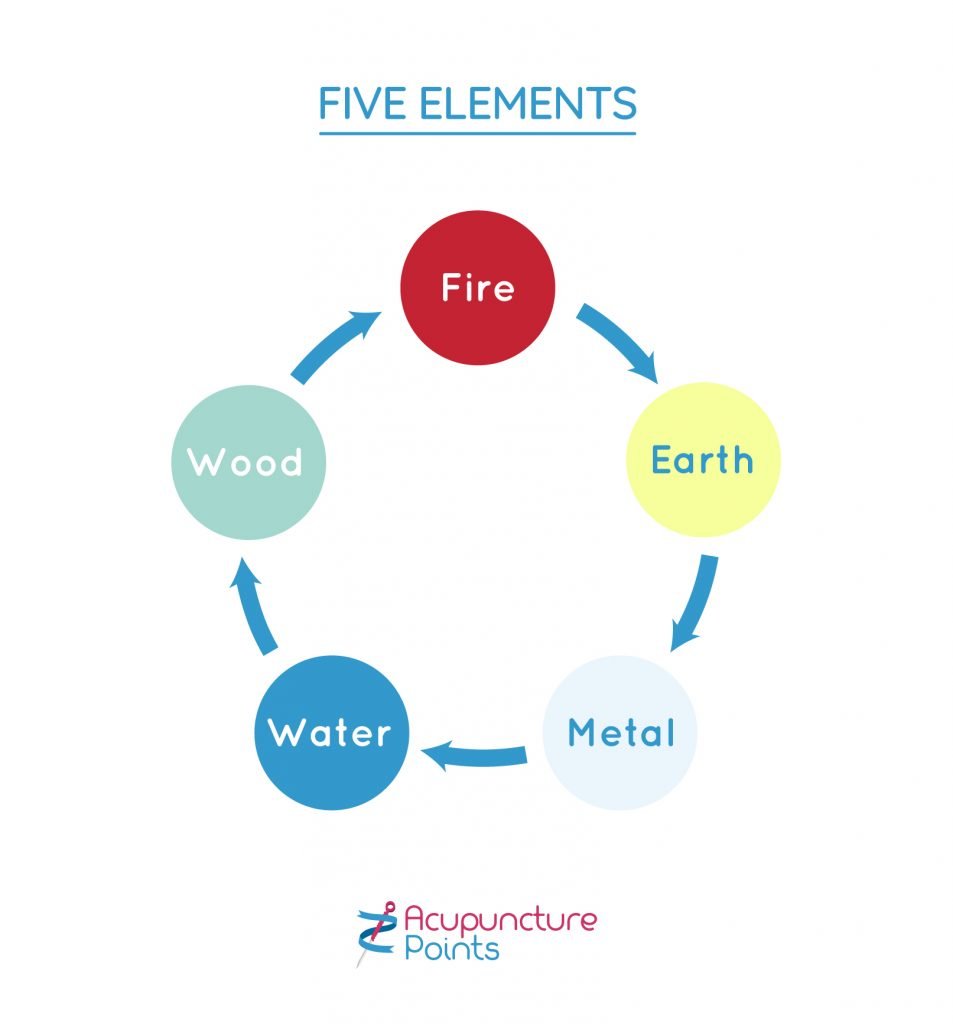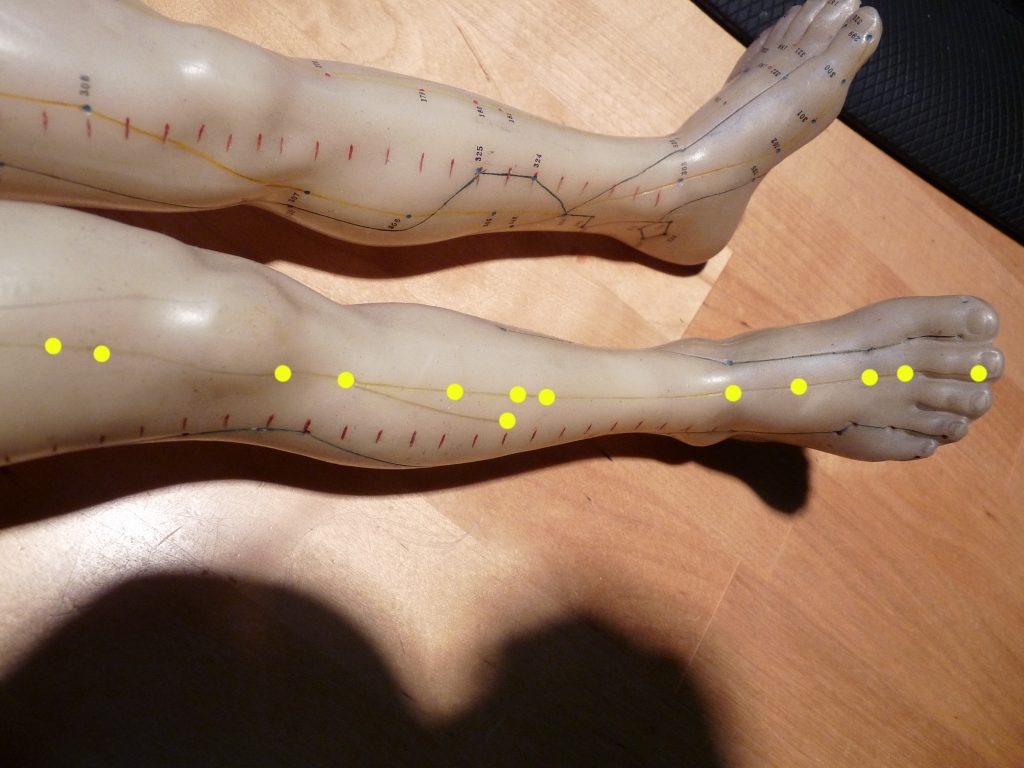Subscribe to the Newsletter
If you are interested in understanding how Traditional Chinese Medicine can improve your life sign up to my newsletter for the latest updates.

All twelve primary acupuncture channels have Five Transport points. These important points are identical to the Five Element points but they are understood and used a different way.
So steel yourself, this page is a bit technical and I’ve put it here only because some patients asked about it. But it isn’t the first page on this site that I’d recommend you read.
What would be the first page I’d recommend you read? Unless you know what you’re looking for, try the Home page.
The original ancient text (the Huangdi Neijing) forming the basis of Chinese medicine is used and pored over to this day by practitioners in many traditions of medicine, including those of Japan, Korea and Vietnam. These ancient texts are basic to their theories.
The part of the Huangdi Neijing called the Divine Pivot (the Ling Shu – itself probably based on texts even older), tersely describes these ‘transport points’ and, amongst other things, how disease penetrates into the body.
The original idea was of a flow of energy from the extremities towards the centre, like that of a well or deep level of water in the hills leading to a spring, becoming a stream then a river and eventually the sea.
The theory and use of these points continues to be discussed. For example, there are questions over the direction of flow of Qi along channels. The Yang ones flow down the body and the Yin channels flow up, yet all the channels have the same series of transport points which start at the extremes (finger or toe-nail) and flow inwards towards the elbow or knee, whichever is their normal direction of flow according to the Chinese ‘clock’.
(I say that they all start on either a finger or a toe but the first transport point on the Kidney channel has gravitated from the small toe to the centre of the sole.)
These points are more widely known also as the Five Element points, the Five Element theory being another important part of this ancient system of health. Five Element theory is huge and in some ways more romantic, appealing to our need for a sense of order in life, and our need to understand why people are as they are.

Understanding the Five Transport point theory is easier if you have not already encountered the Five Element theory. The latter tends to make practitioners think about the points in one particular way, to do with character and movement through life. This makes it harder to understand how the very same acupuncture points could be understood and used another way! But one of the pleasures of practising Chinese medicine is its complexity and the demands it makes on the practitioner to think flexibly and often to combine different approaches for better results during a single treatment.
The Five Transport point theory is simpler in practice but harder to comprehend, perhaps. However, they’re not some kind of tenuous theory dreamt up by a mad Chinaman 3000 years ago! When you understand how they work, using them adds a powerful boost to what you are doing with other acupuncture points.
Every one of the twelve primary channels (meridians) has these five points.
Ancient Chinese medical texts such as The Classic of Difficulties – Han Dynasty say:
That’s about it! But many subsequent authorities have commented on it, filling in the cracks, as it were.

No copy of the original texts exists.
We know it did once exist because it is mentioned so often and the Han dynasty text mentions it as source material. Later writers commented on the ideas of earlier writers, and of course, the language changed over the years too, just as the English language has changed rapidly over the last 50 years, let alone last 2000+ years.
So everyone, for 2000 years, has been talking about what somebody else said!
However, the theory has been put to the test over that period and various ideas have emerged.
Here’s roughly what I understand about them. It’s all part of acupuncture theory which itself is part of what we call TCM theory!
The acupuncture channel points below the elbows and knees do seem more profoundly effective on the general energy of the body than those on the thigh and upper arm.

Or, at least, that’s how we’re taught to use them, so we use them more than the more proximal points. You could argue that we therefore experience them as more effective only because we use them more, thereby consolidating a not very objective view of the matter. Against this stands the clinical experience of two millennia.
And I’ve studied, and use daily, other systems which depend less on this ancient theory, for instance the Dr Tan or Balance method, and the Tung theory and practice.
Qi takes many forms, ranging from Yang, when it is most ephemeral, like ideas, hopes and wishes, to Yin, where it is most formed and solid, like organs and their functions in the torso, the ‘power-house’.
If you look at someone who is excited, you will see them gesticulating, walking or jumping. They move their hands and feet, but their body is what is moved (by legs, for example) but doesn’t move so much, though obviously if you continue for long, your respiration and heart-rate will rise and you’ll get hot.
In this situation, in your hands, it is your fingers that move most. For example, as I type this, I’m sitting relatively still, but my fingers are busy on the keyboard.
Rather than trying to remember exactly what the ancient books said, along with the countless comments made about what they said, I think of the transport points as being a way of manipulating the state of Qi.
Note: as we add point description pages you’ll find links to the points from the name in the tables below. If the text is in red, there should be a link.
| Shu-point | Jing-Well | Ying-Spring | Shu-Stream | Jing-River | He-Sea |
| Element or Phase | Wood | Fire | Earth | Metal | Water |
| Lung | LU-11 Shaoshang | LU-10 Yuji | LU-9 Taiyuan | LU-8 Jingqu | LU-5 Chize |
| Spleen | SP-1 Yinbai | SP2 Dadu | SP3 Taibai | SP5 Shangqiu | SP9 Yinlingquan |
| Heart | HE9 Sahochong | HE8 Shaofu | HE7 Shenmen | HE4 Lingdao | HE3 Shaohai |
| Kidney | K1 Yongquan | K2 Rangu | K3 Taixi | K7 Fuliu | K10 Yingu |
| Pericardium | P9 Zhongchong | P8 Laogong | P7 Daling | P5 Jianshi | P3 Quze |
| Liver | Liv1 Dadun | Liv2 Zingjian | Liv3 Taichong | Liv4 Zhongfeng | Liv8 Ququan |
| Shu-point | Jing-Well | Ying-Spring | Shu-Stream | Jing-River | He-Sea |
| Element or Phase | Metal | Water | Wood | Fire | Earth |
| Large intestine | LI.1 Shangyang | LI.2 Erjian | LI.3 Sanjian | LI.5 Yangxi | LI.11 Quchi |
| Stomach | St45 Lidui | St44 Neiting | St43 Xiangu | St41 Jiexi | St36 Zusanli |
| Small Intestine | SI.1 Shaoze | SI.2 Qiangu | SI.3 Houxi | SI.5 Yanggu | SI.8 Ziaohai |
| Bladder | Bl.67 Zhiyin | Bl.66 Zutonggu | Bl65 Shugu | Bl60 Kunlun | Bl40 Weizhong |
| Three Heater | TH1 Guanchong | TH2 Yemen | TH3 Zhongzhu | TH6 Zhigou | TH10 Tianjing |
| Gall Bladder | GB44 Zuqiaoyin | GB43 Xiaxi | GB41 Zulinqi | GB38 Yangfu | GB34 Yanglingquan |

At the finger and toe tips, Qi is at its most yang, being the furthest from the centre. These points can take the glitches and pressure out of excess yang in the centre.
Glitches include yang boiling over mentally and obstruction from an effervescence of Qi, like froth on boiling water. (Water circulating in central heating systems circulates smoothly up to a certain temperature where it forms steam. At and above that temperature the water-pump revs uncontrollably until cooler, non-boiling water takes its place and the pump’s speed gets back to normal. When revving highly because of the steam, there is no movement in the remaining water in the system, which stagnates.)
In other words, these points help to remove pressure from the ‘cooker’ at the centre. Hence their use for situations like
Other examples that I have used these points for or read about others using include where excitement,shock or emotions have lead suddenly to:
For more on Jing well points, click here.
Please Note: this page is unfinished!
Other pages to read:

Stay in Touch!
No spam, only notifications about new articles and updates.

Book a Video consultation if you want to know more about your symptoms

Why You get Nervous Stomach Anxiety and How to Handle It. Acupuncture has great ways to help.
Subscribe to the Newsletter
If you are interested in understanding how Traditional Chinese Medicine can improve your life sign up to my newsletter for the latest updates.
Subscribe to the Newsletter
If you are interested in understanding how Traditional Chinese Medicine can improve your life sign up to my newsletter for the latest updates.